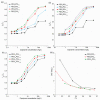Influence of Lyophilization and Cryoprotection on the Stability and Morphology of Drug-Loaded Poly(ethylene glycol- b-ε-caprolactone) Micelles
- PMID: 37112121
- PMCID: PMC10146133
- DOI: 10.3390/polym15081974
Influence of Lyophilization and Cryoprotection on the Stability and Morphology of Drug-Loaded Poly(ethylene glycol- b-ε-caprolactone) Micelles
Abstract
Polymeric micelles are promising carriers for the delivery of poorly water-soluble drugs, providing enhanced drug solubility, blood circulation times, and bioavailability. Nevertheless, the storage and long-term stability of micelles in solution present challenges requiring the lyophilization and storage of formulations in the solid state, with reconstitution immediately prior to application. Therefore, it is important to understand the effects of lyophilization/reconstitution on micelles, particularly their drug-loaded counterparts. Herein, we investigated the use of β-cyclodextrin (β-CD) as a cryoprotectant for the lyophilization/reconstitution of a library of poly(ethylene glycol-b-ε-caprolactone) (PEG-b-PCL) copolymer micelles and their drug-loaded counterparts, as well as the effect of the physiochemical properties of different drugs (phloretin and gossypol). The critical aggregation concentration (CAC) of the copolymers decreased with increasing weight fraction of the PCL block (fPCL), plateauing at ~1 mg/L when the fPCL was >0.45. The blank (empty) and drug-loaded micelles were lyophilized/reconstituted in the absence and presence of β-CD (9% w/w) and analyzed via dynamic light scattering (DLS) and synchrotron small-angle X-ray scattering (SAXS) to assess for changes in aggregate size (hydrodynamic diameter, Dh) and morphology, respectively. Regardless of the PEG-b-PCL copolymer or the use of β-CD, the blank micelles displayed poor redispersibility (<10% relative to the initial concentration), while the fraction that redispersed displayed similar Dh to the as-prepared micelles, increasing in Dh as the fPCL of the PEG-b-PCL copolymer increased. While most blank micelles displayed discrete morphologies, the addition of β-CD or lyophilization/reconstitution generally resulted in the formation of poorly defined aggregates. Similar results were also obtained for drug-loaded micelles, with the exception of several that retained their primary morphology following lyophilization/reconstitution, although no obvious trends were noted between the microstructure of the copolymers or the physicochemical properties of the drugs and their successful redispersion.
Keywords: cryoprotection; lyophilization; micelles; reconstitution; redispersibility; β-CD.
Conflict of interest statement
The authors declare no conflict of interest.
Figures




Similar articles
-
Interrogating the relationship between the microstructure of amphiphilic poly(ethylene glycol-b-caprolactone) copolymers and their colloidal assemblies using non-interfering techniques.J Colloid Interface Sci. 2022 Jan 15;606(Pt 2):1140-1152. doi: 10.1016/j.jcis.2021.08.084. Epub 2021 Aug 17. J Colloid Interface Sci. 2022. PMID: 34492457 Free PMC article.
-
Microstructure-Thermal Property Relationships of Poly (Ethylene Glycol-b-Caprolactone) Copolymers and Their Micelles.Polymers (Basel). 2022 Oct 16;14(20):4365. doi: 10.3390/polym14204365. Polymers (Basel). 2022. PMID: 36297943 Free PMC article.
-
Fine tuning micellar core-forming block of poly(ethylene glycol)-block-poly(ε-caprolactone) amphiphilic copolymers based on chemical modification for the solubilization and delivery of doxorubicin.Biomacromolecules. 2011 Jul 11;12(7):2562-72. doi: 10.1021/bm200375x. Epub 2011 Jun 6. Biomacromolecules. 2011. PMID: 21598958
-
Cryoprotection-lyophilization and physical stabilization of rifampicin-loaded flower-like polymeric micelles.J R Soc Interface. 2012 Mar 7;9(68):487-502. doi: 10.1098/rsif.2011.0414. Epub 2011 Aug 24. J R Soc Interface. 2012. PMID: 21865255 Free PMC article.
-
Preparation and drug loading of poly(ethylene glycol)-block-poly(epsilon-caprolactone) micelles through the evaporation of a cosolvent azeotrope.Pharm Res. 2004 Jul;21(7):1184-91. doi: 10.1023/b:pham.0000033005.25698.9c. Pharm Res. 2004. PMID: 15290858
Cited by
-
A Spike-like Self-Assembly of Polyaspartamide Integrated with Functionalized Nanoparticles.Polymers (Basel). 2024 Jan 15;16(2):234. doi: 10.3390/polym16020234. Polymers (Basel). 2024. PMID: 38257033 Free PMC article.
-
Development of Spray-Dried Micelles, Liposomes, and Solid Lipid Nanoparticles for Enhanced Stability.Pharmaceutics. 2025 Jan 17;17(1):122. doi: 10.3390/pharmaceutics17010122. Pharmaceutics. 2025. PMID: 39861769 Free PMC article.
-
Enhanced wound healing via ROS-triggered release of ascorbyl tetraisopalmitate loaded in ferrocene-based polymer nanoparticles.Redox Biol. 2025 Jul;84:103659. doi: 10.1016/j.redox.2025.103659. Epub 2025 May 9. Redox Biol. 2025. PMID: 40367861 Free PMC article.
References
-
- Zhang J., Zhu C., Hu L., Liu H., Pan H.-C. Effect of freeze-drying process on the physical stability and properties of Voriconazole complex system. Dry. Technol. 2018;36:871–878. doi: 10.1080/07373937.2017.1362648. - DOI
Grants and funding
LinkOut - more resources
Full Text Sources

